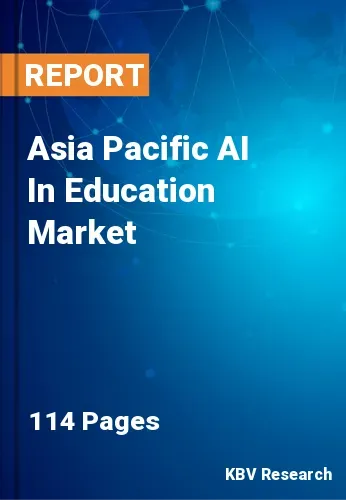The Asia Pacific AI In Education Market would witness market growth of 34.7% CAGR during the forecast period (2022-2028).
It might be challenging for teachers to focus on each student individually and comprehend their unique limits when there are many students in a class. This issue is resolved by artificial intelligence, which develops a model training program for each learner. With the aid of AI-powered technologies, teachers, as well as students, can collaborate to enhance each student's abilities and cognitive skills. A teacher will be in a better position to relate to and effectively communicate with their students when they have a greater understanding of them. The teacher can use AI to track the students' upcoming course schedule and utilize it as a starting point for lesson planning.
Security has become a major concern in many institutions. Prior to allowing students to enter the school, various countries have started utilizing facial recognition technologies to scan their identities and confirm them. The scanners are used to identify the student and record their entry, whether it be at school, the library, or the canteen, in place of the standard student ID cards.
The increasing access of the regional population to education is playing a key role in expanding the regional educational infrastructure. According to the International Trade Administration, 270 million students, as well as 16 million teachers, would be enrolled in more than 500,000 schools in China by 2020. The State Council's body in charge of regulating education in the People's Republic of China is the Ministry of Education. China's Education Modernization 2035 is a blueprint for the country's educational advancement that was released by the State Council in 2019. With universal access to high-quality pre-school education, balanced compulsory schooling, improved vocational education, along with more competitive higher education, this plan aims to construct a modern education system of lifelong learning.
The China market dominated the Asia Pacific AI In Education Market by Country in 2021, and would continue to be a dominant market till 2028; thereby, achieving a market value of $1,072.8 million by 2028. The Japan market is estimated to grow a CAGR of 33.8% during (2022 - 2028). Additionally, The India market would experience a CAGR of 35.5% during (2022 - 2028).
Based on Component, the market is segmented into Solution and Services. Based on Application, the market is segmented into Learning Platform & Virtual Facilitators, Intelligent Tutoring System (ITS), Smart content, Fraud & Risk Management, and Others. Based on End-use, the market is segmented into Higher Education, Corporate Training & Learning, and K-12 Education. Based on Deployment Mode, the market is segmented into Cloud and On-premise. Based on Technology, the market is segmented into Machine Learning and Natural Language Processing (NLP). Based on countries, the market is segmented into China, Japan, India, South Korea, Singapore, Malaysia, and Rest of Asia Pacific.
Free Valuable Insights: The Worldwide AI In Education Market is Projected to reach USD 12.8 Billion by 2028, at a CAGR of 33.5%
The market research report covers the analysis of key stake holders of the market. Key companies profiled in the report include IBM Corporation, Microsoft Corporation, Google LLC, Cognizant Technology Solutions Corporation, Pearson PLC, Amazon Web Services, Inc., Carnegie Learning, Inc., Blackboard, Inc., BridgeU Limited, and DreamBox Learning, Inc.
By Component
By Application
By End Use
By Deployment Mode
By Technology
By Country

Our team of dedicated experts can provide you with attractive expansion opportunities for your business.

